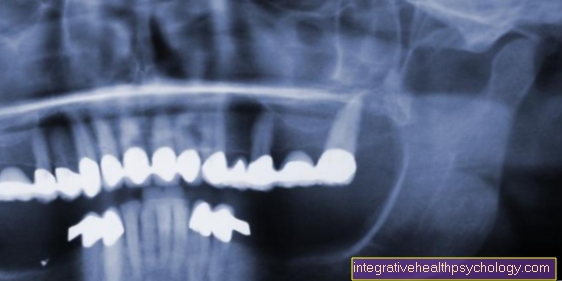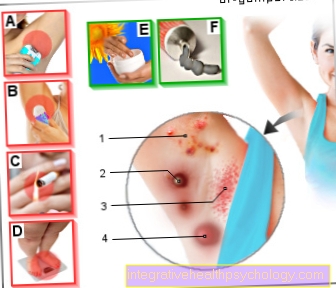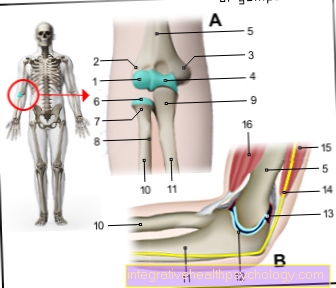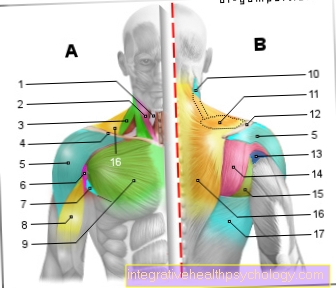Medication for COPD
introduction
Since COPD (Chronic Obstructive Pulmonary Disease) is an inflammatory-degenerative disease in which, among other things, certain parts of the airways, the bronchi, swell, two types of medication are used for your treatment. On the one hand, so-called bronchodilators are used. this is a group of Medicines that use the body's own signaling pathways to cause the bronchi to widen, reducing airway resistance and making breathing easier. On the other hand, from a certain extent of the disease, cortisone is also used, a body-specific substance that has a strong anti-inflammatory effect and thus alleviates the symptoms. However, since cortisone can have many side effects with regular use and makes you susceptible to infection, step therapy for COPD begins with combinations from the group of bronchodilators.
All of these drugs are usually given locally, that is, they work directly on the lungs. They are, for example, powders that are atomized and inhaled or liquids that are also inhaled.

Brochodilators
Bronchodilators are drugs that widen the bronchi, i.e. the larger airways that conduct air. In certain situations, especially when exercising, the body wants to widen the airways and thus to make breathing easier. After exercise and at rest, the airways are then narrowed again. The body uses certain messenger substances and signaling pathways for this purpose. Bronchodilators make use of these endogenous mechanisms by imitating the dilating (= expanding) messenger and signaling substances or by blocking the constricting (= narrowing) substances.
In a COPD patient, the airways are constantly narrowed, on the one hand by mucus, but also by inflammatory swelling. Bronchodilators make breathing easier, which can lead to a great improvement in symptoms.
You may also be interested in this topic: Therapy of COPD
Beta-2 sympathetic homimetics
Body functions that we humans cannot consciously control, such as digestion or the speed of the heartbeat, are controlled by the so-called vegetative nervous system, which can be divided into two opponents: the sympathetic and the parasympathetic. While the parasympathetic nervous system promotes processes that help the body to recover, the sympathetic nervous system promotes processes that make the body capable of fighting or fleeing: it makes the heart beat faster, leads to muscle tension and the mobilization of power reserves, and momentarily throttles irrelevant functions such as digestion and also dilates the bronchi.
Medicines from the group of beta-2 sympathomimetics make use of this principle. They act on the bronchi via the same signal path as the messenger substance of the sympathetic nervous system (noradrenaline or adrenaline) and thus lead to a widening of the bronchi. One can easily deduce that an overdose of such a drug can lead to side effects such as palpitations, sweating and nervousness.
More articles on drugs in the beta-2 sympathomimetic group: Salbutamol spray such as Viani ®
Anticholinergics
Anticholinergics follow a similar principle of action as the beta-2 sympathomimetics described above. They too widen the bronchi, but not by imitating the sympathetic nervous system (see above), but rather by inhibiting its opponent, the parasympathetic nervous system. Its messenger substance is namely acetylcholine, which causes constriction in the bronchi. An antiCHOLINergic inhibits this mechanism and prevents the bronchi from constricting. An overdose can lead to a dry mouth, for example, as the salivation, which is usually promoted by the parasympathetic nervous system, is then also inhibited.
Since beta-2-sympathomimetics and anticholinergics start on a similar, but not the same signal path, they can also be used together, whereby they have a mutually reinforcing (synergistic) effect.
Also read our topic on the drug: Berodual®
PDE4 inhibitors
Phosphodiesterase 4 is an enzyme in many cells (especially in immune cells) that splits the signal substance cAMP and thus promotes inflammatory reactions. If this enzyme is inhibited, the signal substance cAMP persists longer and the inflammation is not promoted. As with cortisone, this reduces the production of mucus and the swelling of the mucous membrane in the bronchi. Studies have shown that PDE4 inhibitors, in combination with other standard drugs in COPD step-by-step therapy, significantly improve symptoms. Furthermore, the drug is very well tolerated and only has side effects in rare cases.
Theophylline
Theophylline is a drug that can alleviate the symptoms of COPD in various ways. On the one hand, it inhibits the phosphodiesterases and thus works via the mechanism described under "PDE-4 inhibitors". But it also blocks a receptor that can be found on the cells of the bronchi and thus leads to a widening of the bronchi. It also stimulates the beating of the cilia in the bronchi, which transport the mucus away. Since theophylline can be overdosed very easily (narrow "therapeutic range") and studies have shown that the risk of dying from cardiovascular disease is increased, theophylline is now only used as a reserve drug in difficult-to-treat COPD cases.
What does cortisone do?
Cortisol is known to many people as the body's “stress hormone”. Cortisol has various functions, all of which aim to ensure that people can function under stress. Among other things, cortisol wakes you up, suppresses energy-intensive inflammatory reactions and promotes breakdown processes, which lead to the release of energy. Cortisone is the transport form of the hormone cortisol.
When cortisone is used locally, the inflammatory reactions occurring there are suppressed via the body's own signaling pathways. In COPD, constant irritation of the bronchi, usually from smoking, causes the mucous membrane to become inflamed and swell up. Cortisone inhibits this inflammation and thus causes a decongestion of the mucous membrane and a reduced mucus reduction, which together causes an improvement in the symptoms.
However, since cortisone also favors local infections by inhibiting the body's own defense, which can be particularly severe in COPD patients, it is only added at the higher levels of COPD step therapy.
More information on this topic: The effects of cortisone such as Side effects of cortisone
When do you need oxygen?
At a certain stage of COPD it can become very difficult for the patient to breathe in enough so that the blood can be completely saturated with oxygen. The Oxygen saturation of the blood can be measured. In healthy people, it is usually 95% -100%. If it drops below 90% in a COPD patient, treatment with oxygen can be considered. The decision also depends on the patient's subjective feeling. Once oxygen therapy has been started, it is often the case that the (psychological) need for oxygen increases and the sick person can no longer easily get away from it. Oxygen therapy is only useful for COPD up to a quantity of one liter / min. Higher doses are actually dangerous over a long period of time. In a healthy person, the respiratory drive is controlled by the amount of CO2 in the blood. Since COPD patients cannot breathe CO2 well, the body gets used to an increased amount in the blood. The control of inhalation and exhalation is therefore made dependent on the oxygen saturation of the blood. If the oxygen content in the blood is increased significantly due to excessive oxygen therapy, the respiratory drive falls massively and dangerous respiratory depression can occur.
Are there any over-the-counter medications?
All of the drugs mentioned require a prescription. At best, expectorant drugs are available in the pharmacy without a prescription (see expectorant drugs). In the early stages of the disease, some home remedies can alleviate the symptoms. For example, inhalation with sage tea or salt water is an option to loosen the mucus and make it easier to cough up. However, the most effective and inexpensive remedy for COPD is definitely to quit smoking, as the disease inevitably and incessantly worsens with continued smoking.
Are there any new drugs that could help soon?
As COPD is increasingly understood, there are also many starting points for new drugs. Currently, most of them focus on anti-inflammatory measures in the bronchi, as this is, so to speak, the “crux of the disease”. One consideration is whether the PDE4 inhibitors, which are currently only available in tablet form, can possibly also be administered by inhalation and thus locally and directly in the lungs effectively. In addition, research is being carried out on a drug that may suppress the production of inflammatory messenger substances via a new path (inhibition of p38-MAP kinase).
Another interesting group are the CXCR-2 antagonists, which could prevent the accumulation of inflammatory cells in the lungs. However, since drugs always have to go a long way to get approved, it is not clear when and whether these drugs will come onto the market.
Expectorant drugs
In pharmacies, various expectorant drugs are sold without a prescription, which are supposed to make breathing easier, even with COPD. Among other things, there is the so-called Ambroxol, which has a very well-documented effectiveness. Bromhexine, which is also available free of charge in pharmacies, is related to Ambroxol. However, since it is partially converted to the more effective Ambroxol in the body, it is advisable to try Ambroxol directly.
Another very well-known drug is ACC (acetylcysteine), which is also used as an expectorant for colds and also as an antidote for acetaminophen poisoning. However, its effectiveness as an expectorant has only been proven to a limited extent. A subjective improvement of stubborn mucus is often achieved through inhalation, be it with water, salt water or tea.
Also read: ACC acute ®
Recommendations from our editorial team
- Salbutamol spray for COPD
- Viani ® for COPD
- Therapy of COPD
- Effects of cortisone
- Course of COPD
Exclusion of liability / disclaimer
We would like to point out that medication must never be discontinued, applied or changed independently without consulting your doctor.
Please note that we cannot claim that our texts are complete or correct. The information may be out of date due to current developments.





























